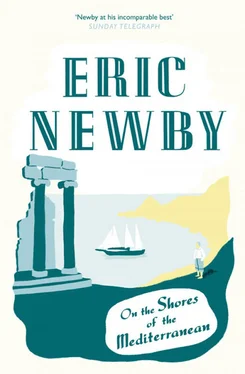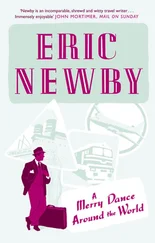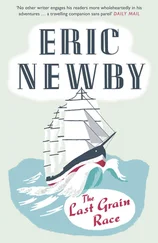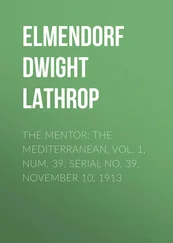We ate the croissants and drank coffee running along the shores of Lago Maggiore. Cork and cedar trees rose above the early mist on the Borromean Islands and the place names on the map – Stresa and Locarno – were those of long-forgotten treaties made before the war. It was going to be a lovely day. At Milan, at 10.00, the papers came on board with pictures of a frigate burning in the Falkland Islands.
Lunch on the train, £15 ($21) a head if you had to pay for it, was tagliatelle with butter, small chickens in a delicious sauce, smoked salmon, Parma ham, strawberry tart, the most delicious lemon cake and more of the Laurent-Perrier champagne on which everyone had been over-indulging themselves. Then, three hours out of Milan, we rumbled through the hideous environs of Mestre and out along the causeway to the beautiful, sinking, stinking city in the Lagoon.
We arrived at Santa Lucia Station at 14.44 to be greeted on the platform when we descended by the station master, the massed concierges of the Cipriani, the Gritti and the Danieli, the assembled staff of the Venice – Simplon – Orient Express and the Gondolieri Chorus.
Miss Minnelli left in another little black number decorated with bugle beads. She told me she had enjoyed the trip. We never saw her again. Boats took us away up the Grand Canal, a vision in the sunshine, to stay at the Cipriani for free. It was all over.
Leaving Venice some considerable time later, this time in a van by the causeway across the Lagoon, turning right at Mestre on the old main road to Trieste, we crossed the plains of the Veneto and Venezia Giulia. For much of the way the road, as are most of the other main roads in northern Italy, is lined with developments, factories and furniture showrooms mostly, whose owners now choose what were previously remote rural locations for them, so that for long periods of time it is impossible to see the country on either side at all.
It is country which when one can see it is of endless flatness, through which the irrigation ditches stretch away to what seems like infinity between the high embankments, just as they do in the Po Delta. In summer, in the heat of the day, when the mirage is operating, this country sometimes looks more like a jelly than terra firma. In it, in summer, the farmhouses and villages stand like islands isolated in seas of ripening corn and grapes. (In winter they stand in seas of freezing mud.) In autumn, in late September or October, the contadini in their wide-brimmed straw hats, at this season engaged in the vendemmia , take shelter beneath the vines, around half past nine or so, by which time it is already hot, to eat their merenda , just as we do in the vineyards around I Castagni.
The rivers that flow down through the plain from the Alps into the lagoons and marshes that fringe the coast are the Piave, the Tagliamento and the Isonzo, which first sees the light of day as the Soča, bubbling up over clean sand in a deep cleft in the rock in the Julian Alps in Yugoslavia, each of them in full, sometimes dangerous, flood in spring when the mountain snows melt. In the hot weather long reaches of them are often nothing more than arid wildernesses of shingle with a few livid green stagnant pools among them. Rivers that were practically unheard-of in the outside world until the First World War when hundreds of thousands of Italians and Austro-Hungarians died fighting one another on their banks.
Having crossed the Isonzo, the most eastward of these rivers, we arrived in the late afternoon in Monfalcone, a rather sad shipbuilding and industrial town on the shores of the Gulf of Panzano, an inlet at the head of the Gulf of Trieste, sad-looking because it was more or less destroyed in the First World War and then rebuilt in the early twenties at a time when domestic as well as public architecture was rather sad anyway.
The only old building of note is the castle, and even that is not exciting as castles go, although the view from it is magnificent, over what is actually only a small part of the vast plain which extends uninterruptedly for some 300 miles from the Julian Alps to the Maritime and the Cottian Alps in which the Po rises on the French frontier beyond Turin, with the shining lagoons reaching into it from the sea and with towers and campanili rising into the air above it, of which that of the cathedral of Aquileia, the Roman city sacked by Attila, is the most easily identifiable.
The castle stands on the very edge of what the Italians call Il Carso, the Yugoslavs call the Kras and German-speakers the Karst, a wilderness of limestone here rising in a steep escarpment abruptly above the town and the plain, like a whale surfacing from the depths of the ocean, scarred by quarrying, utterly bare except for a few plantations of conifers and innumerable electric pylons which protrude from it like harpoons. Having fought and negotiated so ferociously either to obtain or retain it, it would be comical, if it was not tragic, to see how the Italians have treated what they are always going on about as their patrimony.
Much of the Carso is bare rock, but parts of it are covered with ash, rowan, hawthorn shrubs and holm oaks, the last vestigial remains of the primeval forest that provided some of the wooden piles on which, miraculously, Venice still stands, although now plantations of conifers are rapidly changing its appearance.
Here, among what in some places look like torrents of rock, the making of the fields, before the coming of the bulldozer, was the back-breaking work of generations of men and women and their children. Here, you can still see piles of pale, rain-washed stones, as much as ten feet high and sixty feet long, like great burial cairns, all hand-picked from this wilderness to make a field of red earth perhaps three feet deep and thirty yards long in which vines, corn, turnips or potatoes could be grown.
It is a place of extremes. In winter the fearful wind called by the Slovenes the Kraška Burja , by the Italians the Bora , sweeps over the plateau from the north-east, sometimes attaining a velocity of up to 130 mph and in the past upsetting heavily laden ox-carts and even halting trains on the railway line from Trieste to Ljubljana, although it now rarely blows with such ferocity, possibly because the plateau is being protected by the reafforestation.
The early part of the year is particularly beautiful. The grass is fresh and green and carpeted with snowdrops, daffodils and lilies of the valley, and the hillsides are covered with narcissus.
In summer a huge, brooding silence envelops the Carso, a silence accentuated by the endless shrilling of cicadas that seems eventually to become part of the silence itself. The woods have a sinister, claustrophobic feeling about them and one has the sensation of being watched, and one is being watched anywhere close to the Yugoslav – Italian frontier, across which, walking in the woods, it is easy to stray.
Here in the Carso, ten minutes after the most violent rainstorm, there is no water to be seen; it has all gurgled away through fissures in the rock. For the Kras is hollow. Beneath it there is a whole subterranean world, only a minute part of it explored, of vast caverns, dark, secret rivers and black, icy lakes. From the air it looks as if it has been subjected to intense artillery bombardment, as it was when it was a major battlefield in the First World War. Its entire surface is pitted with craters but these are natural phenomena. The largest are called, in Slovene, kolisevke , basins with vertical sides as much as 300 feet deep and a quarter of a mile wide, huge caves whose roofs have collapsed. A smaller variety, doline , are blocked-up swallow holes that once led underground, funnel-shaped depressions anything from six to sixty feet deep and up to three hundred feet in diameter which contain the best earth and are cultivated as sunken fields.
Читать дальше












